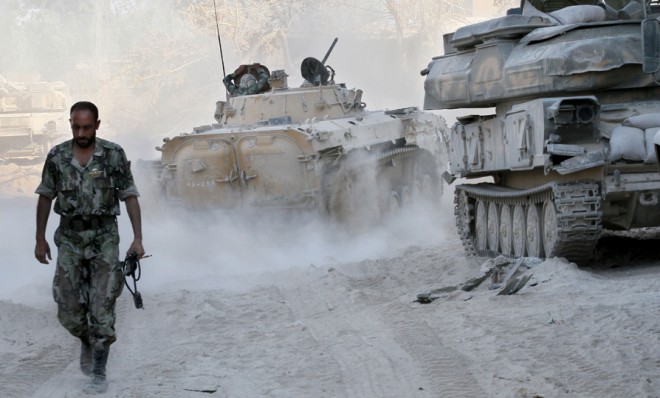4 likely targets in the looming military strike on Syria
The strikes are meant to degrade Assad's ability to use chemical weapons


Syrian military personnel aren't waiting for Western missiles to start raining down on them. Rebel commanders in Damascus say government soldiers are scattering, leaving high-value army installations and heading for shelter in places unlikely to figure on any target list.
"To all intents and purposes, the army's command and control compounds have been evacuated," says Abu Ayham, a commander in the Ansar al-Islam rebel brigade in Damascus.
The U.S. is trying to rally support in Congress and at the United Nations for a possible strike in retaliation for the Syrian government's alleged use of chemical weapons against its own people. Obama administration officials have leaked many elements of the possible strikes, which reportedly would involve cruise missiles and last just one to three days.
The Week
Escape your echo chamber. Get the facts behind the news, plus analysis from multiple perspectives.

Sign up for The Week's Free Newsletters
From our morning news briefing to a weekly Good News Newsletter, get the best of The Week delivered directly to your inbox.
From our morning news briefing to a weekly Good News Newsletter, get the best of The Week delivered directly to your inbox.
Pentagon officials have been working on a list of potential targets since shortly after last week's chemical attack in a rebel-held area outside Damascus, with a focus on degrading Assad's ability to use chemical weapons. Here are four types of military installations likely to be in the crosshairs:
1. Airstrips
Military experts expect the airstrikes to focus on degrading the infrastructure Syrian President Bashar al-Assad's forces need to deliver shells loaded with sarin nerve agent and other deadly chemicals. That means the primary targets will include military airstrips, airplanes, and helicopters used to attack rebel forces, says Dion Nissenbaum at The Wall Street Journal.
2. Facilities used to deploy chemical arms
A free daily email with the biggest news stories of the day – and the best features from TheWeek.com
Punishing Assad over the chemical attacks presumably would call for targeting command facilities responsible for launching Syria's WMD. Destroying a significant number of launching mechanisms could be tricky, says Max Fisher at The Washington Post, "given that the regime is thought to have huge quantities and to move them around the country. It's unlikely that the strikes will target chemical weapons specifically, as this risks dispersing the chemical agents."
3. Elite units
The airstrikes will also be intended to "get President Assad's attention and to persuade him not to resort to chemical weapons in the future," says Jonathan Marcus at BBC News. To make the bombing hurt, Marcus says, any long-range campaign would also go after the headquarters and barracks of elite units on which he has relied on to keep rebel forces at bay for more than two years of civil war.
Those facilities might include the Mazzeh and Qasioun military complexes, which are home to Syria's special forces and the elite Republican Guard — two powerful units close to Assad, according to The Washington Post.
4. Syrian artillery
The main thrust of the attack, according to The New York Times, is expected to come from four U.S. destroyers, which are already deployed within range of Syria in the Mediterranean. Each ship carries about two dozen Tomahawk cruise missiles — low-flying projectiles that are highly accurate even when launched up to 1,000 miles away.
They would probably be aimed at Syrian rocket and artillery sites, U.S. officials tell the Times, but they won't have a tremendous tactical impact, since each delivers less explosive power than a single 1,000-pound air-dropped bomb.
The plan of attack is reportedly still in the works. Everything we've seen so far, however, is consistent with reports that the West is looking to send Assad a stern message, but not to turn the tide of the war.
Harold Maass is a contributing editor at The Week. He has been writing for The Week since the 2001 debut of the U.S. print edition and served as editor of TheWeek.com when it launched in 2008. Harold started his career as a newspaper reporter in South Florida and Haiti. He has previously worked for a variety of news outlets, including The Miami Herald, ABC News and Fox News, and for several years wrote a daily roundup of financial news for The Week and Yahoo Finance.
-
 Political cartoons for January 4
Political cartoons for January 4Cartoons Sunday's political cartoons include a resolution to learn a new language, and new names in Hades and on battleships
-
 The ultimate films of 2025 by genre
The ultimate films of 2025 by genreThe Week Recommends From comedies to thrillers, documentaries to animations, 2025 featured some unforgettable film moments
-
 Political cartoons for January 3
Political cartoons for January 3Cartoons Saturday's political cartoons include citizen journalists, self-reflective AI, and Donald Trump's transparency
